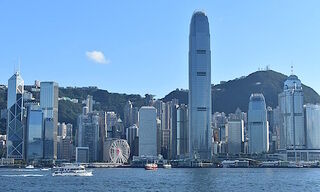Gerald Goh: «The Art Market is Absurdly Inefficient»
The illiquidity of the traditional art market is a challenge for many creators, coupled with other issues such as inefficiency and opacity. An end-to-end tokenization solution could be the way to help unlock the hidden wealth in artworks, Gerald Goh writes in his essay on finews.first.
finews.first is a forum for authors to comment on economic and financial topics.
In recent years, Singapore has witnessed a notable influx of wealthy investors, with the Chinese forming a considerable portion of these new arrivals. In 2022, Singapore's ultra-high net worth population increased by 6.9 percent to 4,498, according to Knight Frank data, up from 4,206 in 2021. The number of single family offices has jumped nearly three-fold since the pandemic began.
The accompanying surge in Chinese-owned art venues in Singapore has also garnered significant attention. These galleries not only serve as showcases for high-value artworks, but they also hope to attract some of the new money flowing into the republic. Despite this increase in the number of wealthy prospects, owners and artists have found it challenging to gain commercial success.
Compared to Hong Kong, the art market in Singapore is relatively young with only a small base of collectors circulating among an ever-growing number of galleries and artists based here. A chat with Amber Shaw from Art Works, an art advisory firm in the city state, revealed that there is also a certain market fatigue plaguing the art scene here. New artists find it hard to get their break while collectors continually encounter the same names and works. The situation sounds like a «Gordian Knot». Could the solution lie in the poster child of the blockchain world: real-world asset tokenization?
«Liquidity doesn’t come about simply because you have tokenized something»
Traditionally, there are several ways to unlock liquidity in art. Besides selling the piece, a collector could use their artworks as collateral to secure loans, lease them to museums, businesses or private individuals, and receive royalties from licensing the art for prints, posters, or digital uses.
In recent years, art tokenization has been enthusiastically pitched as a way for artists and owners to obtain liquidity from their art. Touted as a secure and efficient solution, tokenization «breaks up» a piece of art into digital tokens, facilitating fractional ownership and vis-a-vis lowering the price barrier. As the co-founder of a digital asset specialist that facilitated the tokenization of a Picasso back in 2021, there are limitations that owners and artists need to be aware of. Liquidity (to put it plainly, money) doesn’t come about simply because you have tokenized something.
«Tokenization projects can only succeed when there is an accompanying demand in the secondary market»
While tokenization addresses the access problem for investors keen to enter the art market without the prohibitive amount of capital often required. Tokenization projects can only succeed when there is an accompanying demand in the secondary market for the tokens generated. This means, investors must believe that the project will appreciate over time and the tokens are worth holding onto.
As Beijing-born artist and academic Allison Liu pointed out, the risk of holding an artwork is transferred, through tokenization, from the owner to the token holders. While the token issuer (in this case, the owner) will be able to obtain much-desired liquidity through the sale of the tokens, it is the investors who will now have to either find secondary buyers for their tokens or wait for an exit event to happen.
«Token-holders need to know if their tokens allow them to exercise their rights to the original artwork»
Unlike traditional art sales, these tokens are traded on specialized platforms and the ease of trading can also affect their appeal to investors. If tokens could only be bought and sold in a convoluted process, again, this would impact their attractiveness to investors.
Finally, who does the artwork really belong to? Do the tokens bestow ownership rights onto investors? How then are decisions around the sale of the artwork made? Token-holders need to know if their tokens allow them to exercise their rights to the original artwork. Whether it’s loaning the artwork to a museum or putting it up for auction, it needs to be clear just how much of a say an investor has.
«The art market is absurdly inefficient and opaque»
This being said, it is not altogether an unreasonable idea that tokenization could be the key to unlocking art’s hidden wealth. The art market is absurdly inefficient and opaque, and filled with many intermediaries that lengthen the transaction process and add to the fees. An end-to-end blockchain-powered tokenization solution that uses smart contracts to authenticate provenance, confirm ownership, is regulatory compliant, and allows trading to be conducted with ease can indeed allow investors to profit from an asset class previously seen as hard-to-access in a direct and fractional manner.
The successful tokenization, and the subsequent sale, of a Picasso painting by Sygnum and Artemundi highlights the transformative potential of tokenization in the art market. The resultant returns for token holders demonstrate the value proposition of this innovative approach. Transforming the intangible value of art into tangible returns will first require an «asset grade» piece, determined by the artist’s ability to make an impact in history, their marketing finesse, if are they creating too much or too little work and their audience base.
Author’s note: All persons mentioned in this article are neither clients nor affiliates of Sygnum.
Gerald Goh is Co-Founder and CEO of Sygnum Singapore.
Previous contributions: Rudi Bogni, Peter Kurer, Rolf Banz, Dieter Ruloff, Werner Vogt, Walter Wittmann, Alfred Mettler, Robert Holzach, Craig Murray, David Zollinger, Arthur Bolliger, Beat Kappeler, Chris Rowe, Stefan Gerlach, Marc Lussy, Nuno Fernandes, Richard Egger, Maurice Pedergnana, Marco Bargel, Steve Hanke, Urs Schoettli, Ursula Finsterwald, Stefan Kreuzkamp, Oliver Bussmann, Michael Benz, Albert Steck, Martin Dahinden, Thomas Fedier, Alfred Mettler, Brigitte Strebel, Mirjam Staub-Bisang, Nicolas Roth, Thorsten Polleit, Kim Iskyan, Stephen Dover, Denise Kenyon-Rouvinez, Christian Dreyer, Kinan Khadam-Al-Jame, Robert Hemmi, Anton Affentranger, Yves Mirabaud, Katharina Bart, Frédéric Papp, Hans-Martin Kraus, Gerard Guerdat, Mario Bassi, Stephen Thariyan, Dan Steinbock, Rino Borini, Bert Flossbach, Michael Hasenstab, Guido Schilling, Werner E. Rutsch, Dorte Bech Vizard, Katharina Bart, Maya Bhandari, Jean Tirole, Hans Jakob Roth, Marco Martinelli, Thomas Sutter, Tom King, Werner Peyer, Thomas Kupfer, Peter Kurer, Arturo Bris, Frederic Papp, James Syme, Dennis Larsen, Bernd Kramer, Armin Jans, Nicolas Roth, Hans Ulrich Jost, Patrick Hunger, Fabrizio Quirighetti, Claire Shaw, Peter Fanconi, Alex Wolf, Dan Steinbock, Patrick Scheurle, Sandro Occhilupo, Will Ballard, Nicholas Yeo, Claude-Alain Margelisch, Jean-François Hirschel, Jens Pongratz, Samuel Gerber, Philipp Weckherlin, Anne Richards, Antoni Trenchev, Benoit Barbereau, Pascal R. Bersier, Shaul Lifshitz, Klaus Breiner, Ana Botín, Martin Gilbert, Jesper Koll, Ingo Rauser, Carlo Capaul, Markus Winkler, Thomas Steinemann, Christina Boeck, Guillaume Compeyron, Miro Zivkovic, Alexander F. Wagner, Eric Heymann, Christoph Sax, Felix Brem, Jochen Moebert, Jacques-Aurélien Marcireau, Ursula Finsterwald, Michel Longhini, Stefan Blum, Zsolt Kohalmi, Nicolas Ramelet, Søren Bjønness, Gilles Prince, Salman Ahmed, Peter van der Welle, Ken Orchard, Christian Gast, Jeffrey Bohn, Juergen Braunstein, Jeff Voegeli, Fiona Frick, Stefan Schneider, Matthias Hunn, Andreas Vetsch, Fabiana Fedeli, Kim Fournais, Carole Millet, Swetha Ramachandran, Thomas Stucki, Neil Shearing, Tom Naratil, Oliver Berger, Robert Sharps, Tobias Mueller, Florian Wicki, Jean Keller, Niels Lan Doky, Johnny El Hachem, Judith Basad, Katharina Bart, Thorsten Polleit, Peter Schmid, Karam Hinduja, Zsolt Kohalmi, Raphaël Surber, Santosh Brivio, Mark Urquhart, Olivier Kessler, Bruno Capone, Peter Hody, Michael Bornhaeusser, Agnieszka Walorska, Thomas Mueller, Ebrahim Attarzadeh, Marcel Hostettler, Hui Zhang, Michael Bornhaeusser, Reto Jauch, Angela Agostini, Guy de Blonay, Tatjana Greil Castro, Jean-Baptiste Berthon, Marc Saint John Webb, Dietrich Goenemeyer, Mobeen Tahir, Didier Saint-Georges, Serge Tabachnik, Vega Ibanez, David Folkerts-Landau, Andreas Ita, Michael Welti, Fabrizio Pagani, Roman Balzan, Todd Saligman, Christian Kaelin, Stuart Dunbar, Carina Schaurte, Birte Orth-Freese, Gun Woo, Lamara von Albertini, Ramon Vogt, Andrea Hoffmann, Niccolò Garzelli, Darren Williams, Benjamin Böhner, Mike Judith, Jared Cook, Henk Grootveld, Roman Gaus, Nicolas Faller, Anna Stünzi, Thomas Höhne-Sparborth, Fabrizio Pagani, Guy de Blonay, Jan Boudewijns, Sean Hagerty, Alina Donets, Sébastien Galy, Roman von Ah, Fernando Fernández, Georg von Wyss, Stefan Bannwart, Andreas Britt, Frédéric Leroux, Nick Platjouw, Rolando Grandi, Philipp Kaupke, Gérard Piasko, Brad Slingerlend, Dieter Wermuth, Grégoire Bordier, Thomas Signer, Gianluca Gerosa, Christine Houston, Manuel Romera Robles, Fabian Käslin, Claudia Kraaz, Marco Huwiler, Lukas Zihlmann, Sherif Mamdouh, Harald Preissler, Taimur Hyat, Philipp Cottier, Andreas Herrmann, Camille Vial, Marcus Hüttinger, Serge Beck, Alannah Beer, Stéphane Monier, Ashley Simmons, Lars Jaeger, Shanna Strauss-Frank, Bertrand Binggeli, Marionna Wegenstein, George Muzinich, Jian Shi Cortesi, Razan Nasser, Nicolas Forest, Joerg Ruetschi, Reto Jauch, Bernardo Brunschwiler, Charles-Henry Monchau, Philip Adler, Ha Duong, Teodoro Cocca, Beat Wittmann, Jan Brzezek, Florin Baeriswyl, Nicolas Mousset, Beat Weiss, Pascal Mischler, Andrew Isbester, Konrad Hummler, Jan Beckers, Martin Velten, Katharine Neiss, Claude Baumann, Daniel Roarty, Kubilay Yalcin, Robert Almeida, Karin M. Klossek, Marc Taverner, Charlie T. Munger, Daniel Kobler, Patrick Stauber, Colin Vidal, Anna Rosenber, Judith Wallenstein, Adriano Lucatelli, Daniel Goleman, Val Olson, Brice Prunas, Francesco Magistra, Brigitte Kaps, Frances Weir, Luis Maldonado, Francesco Magistra, Nadège Lesueur-Pène, Massimo Pedrazzini, Eric Sarasin, David Ellis, Dina Ting, Christopher Gannatti, Shaniel Ramjee, Mihkel Vitsur, Nannette Hechler-Fayd’herbe, Ralph Ebert, Chris Cottorone, and Francesco Mandalà.



















